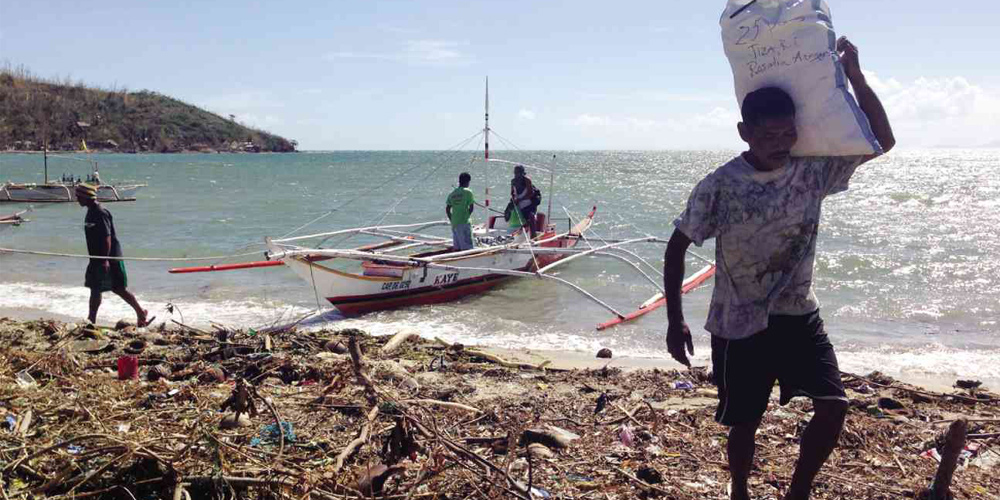
THOUGH barely visible from this vantage point, the destruction left by Supertyphoon “Yolanda” is life-changing for residents of Olotayan, an island village of Roxas City in Capiz province. MARICAR CINCO/INQUIRER SOUTHERN LUZON
ROXAS CITY, Capiz—The island village is not even on the map of Roxas City, the capital of Capiz province, that the Inquirer got from the provincial tourism office.
Olotayan, also called “Little Boracay” for its long, white beaches and crystal clear water like that of the country’s premier tourist destination in Aklan province and a half-an-hour boat ride from the Panay mainland, was wiped out by Supertyphoon “Yolanda.”
From afar, Olotayan is a mound of denuded forest. Up close, it is a litter of toppled banana trees, collapsed nipa huts, and wrecked fishing boats abandoned on the shoreline.
The Inquirer on Friday met the village captain, Manuel Aninang, at the port of Barangay Banica, the jump-off point to the island, as he was loading sacks of relief stocks for his constituents. The village has about 900 residents, and Aninang said the rations for that day came from a “kababayan” working abroad.
Since the aftermath of the typhoon, Aninang said he had been traveling back and forth to the island, soliciting help and packing relief items donated by Olotayan residents and their relatives who had migrated to the United States and Canada.
“I even asked my children abroad to send money so we could buy the relief,” he said.
The village officials unloaded the goods at Señor Sto. Niño Chapel, where families have sought refuge from Yolanda’s onslaught. The ceiling of the newly built chapel gave in when a tornado hit the island.
“I took my children with me and we ran outside. I think I even pushed some people away from the [chapel’s] door just so we could run away from the whirling wind,” Alma Manto, a mother of four, recalled the ordeal.
As Aninang announced the relief from a donor family, an old woman in the crowd suddenly threw the Inquirer a hug. When asked later what he had said in Hiligaynon, he replied: “I just said how thankful we were that people could now learn how devastated our island was.”
Except for the relief stocks from the city government delivered two days after the typhoon, Aninang said no other government aid reached the island, leaving them with no choice but to pool donations on their own.
The island’s parish priest Taz Lasola, who celebrates Mass once a month in Olotayan, organized a relief drive on his own. “Some people coursed their donations to the church so it would be delivered faster,” he said.
One resident, Jeanet Arenajo, 50, said the community would not last long with rations of rice and canned goods. “We need our houses and fishing boats fixed. We could not go to the city because most of the boats were broken,” she said.
A generator that supplies electricity to the island was destroyed. The barge that delivers potable water from the city twice a month was also damaged.
“Water is our problem. We have wells here, but a part of my ceiling fell into one of them. I haven’t even taken it out yet,” Arenajo said.
The small huts of the residents rented out to the tourists who travel to the island from Boracay were also leveled.
One fisherman cried out: “Please take photos of the damage so people could see.”
“We need help, even salt and vetsin (monosodium glutamate) we had to buy from the city,” another said.
The village had one fatality— Hilario Carpina, whose neck was pierced with a steel rod when part of the school building collapsed. The island has one public elementary school and four of its classrooms were damaged.
“But we are told classes are to resume on Monday (Nov. 18) so Mama already dried out our books soaked during the typhoon,” 11-year-old Mark Angelo Mana-ay said.
The island never had a medical facility. After Carpina died, the men carried his coffin on bamboo poles to the island’s cemetery on top of the mountain. “It’s not too far, but quite steep, the climb is worth 10 of your sins being forgiven,” Aninang said.